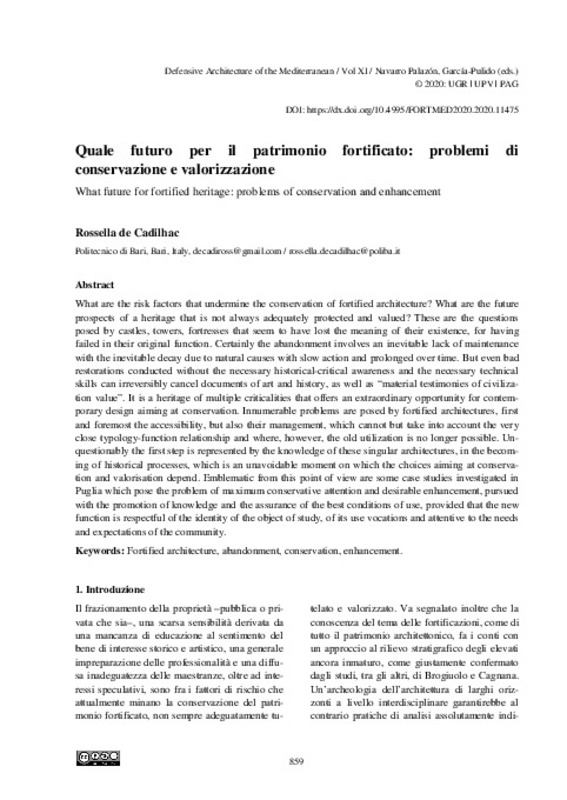JavaScript is disabled for your browser. Some features of this site may not work without it.
Buscar en RiuNet
Listar
Mi cuenta
Estadísticas
Ayuda RiuNet
Admin. UPV
Quale futuro per il patrimonio fortificato: problemi di conservazione e valorizzazione
Mostrar el registro sencillo del ítem
Ficheros en el ítem
| dc.contributor.author | de Cadilhac, Rossella
|
es_ES |
| dc.date.accessioned | 2020-06-22T08:07:56Z | |
| dc.date.available | 2020-06-22T08:07:56Z | |
| dc.date.issued | 2020-05-15 | |
| dc.identifier.isbn | 9788490488560 | |
| dc.identifier.uri | http://hdl.handle.net/10251/146746 | |
| dc.description.abstract | [EN] What are the risk factors that undermine the conservation of fortified architecture? What are the future prospects of a heritage that is not always adequately protected and valued? These are the questions posed by castles, towers, fortresses that seem to have lost the meaning of their existence, for having failed in their original function. Certainly the abandonment involves an inevitable lack of maintenance with the inevitable decay due to natural causes with slow action and prolonged over time. But even bad restorations conducted without the necessary historical-critical awareness and the necessary technical skills can irreversibly cancel documents of art and history, as well as “material testimonies of civilization value”. It is a heritage of multiple criticalities that offers an extraordinary opportunity for contemporary design aiming at conservation. Innumerable problems are posed by fortified architectures, first and foremost the accessibility, but also their management, which cannot but take into account the very close typology-function relationship and where, however, the old utilization is no longer possible. Unquestionably the first step is represented by the knowledge of these singular architectures, in the becoming of historical processes, which is an unavoidable moment on which the choices aiming at conservation and valorisation depend. Emblematic from this point of view are some case studies investigated in Puglia which pose the problem of maximum conservative attention and desirable enhancement, pursued with the promotion of knowledge and the assurance of the best conditions of use, provided that the new function is respectful of the identity of the object of study, of its use vocations and attentive to the needs and expectations of the community. | es_ES |
| dc.language | Italiano | es_ES |
| dc.publisher | Editorial Universitat Politècnica de València | es_ES |
| dc.rights | Reconocimiento - No comercial - Sin obra derivada (by-nc-nd) | es_ES |
| dc.subject | Fortifications | es_ES |
| dc.subject | Mediterranean | es_ES |
| dc.subject | Modern age | es_ES |
| dc.subject | Built Heritage | es_ES |
| dc.subject | Fortified architecture | es_ES |
| dc.subject | Abandonment | es_ES |
| dc.subject | Conservation | es_ES |
| dc.subject | Enhancement. | es_ES |
| dc.title | Quale futuro per il patrimonio fortificato: problemi di conservazione e valorizzazione | es_ES |
| dc.type | Capítulo de libro | es_ES |
| dc.type | Comunicación en congreso | es_ES |
| dc.identifier.doi | 10.4995/FORTMED2020.2020.11475 | |
| dc.rights.accessRights | Abierto | es_ES |
| dc.description.bibliographicCitation | De Cadilhac, R. (2020). Quale futuro per il patrimonio fortificato: problemi di conservazione e valorizzazione. Editorial Universitat Politècnica de València. 859-866. https://doi.org/10.4995/FORTMED2020.2020.11475 | es_ES |
| dc.description.accrualMethod | OCS | es_ES |
| dc.relation.conferencename | FORTMED2020 - Defensive Architecture of the Mediterranean | es_ES |
| dc.relation.conferencedate | Octubre 01-03,2020 | es_ES |
| dc.relation.conferenceplace | Granada, Spain | es_ES |
| dc.relation.publisherversion | http://ocs.editorial.upv.es/index.php/FORTMED/FORTMED2020/paper/view/11475 | es_ES |
| dc.description.upvformatpinicio | 859 | es_ES |
| dc.description.upvformatpfin | 866 | es_ES |
| dc.type.version | info:eu-repo/semantics/publishedVersion | es_ES |
| dc.relation.pasarela | OCS\11475 | es_ES |








